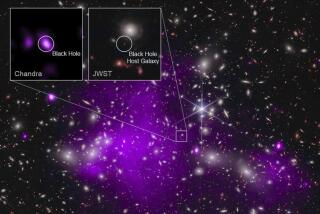SCIENCE / ASTRONOMY : ‘Blobs’ Suggest a Black Hole at Center of Galaxy
- Share via
ALBUQUERQUE — Giant “blobs” of material have been discovered around a mysterious object near the center of the Milky Way Galaxy, leading scientists to believe they may be getting their best look yet at one of the most baffling objects in the universe--a black hole.
It isn’t possible to actually see a black hole, and no one has been able to prove that they exist, because a black hole would be so dense that even light would not escape its gravity.
But black holes exist in theory--and probably in fact--as part of the legacy of Albert Einstein. Despite years of searching, they remain the most elusive trophies in the astronomical zoo.
But armed with increasingly powerful tools, including giant radio telescopes, scientists believe that they are getting closer to proving that black holes do exist, even if they cannot be seen.
The search consists mainly of looking for evidence of the kind of violent activity that should take place in a black hole’s immediate neighborhood. Theoretically, as the black hole captures material within its gravitational reach, atoms and molecules literally should be ripped apart, sending out various types of radiation that can be studied from as far away as Earth.
Wednesday, scientists told the American Astronomical Society meeting here that they believe that they have identified a series of giant “blobs”--most likely clouds of hot, charged gas particles--around an object known as Sagittarius A, which had been discovered previously by an infrared telescope.
The “blobs,” they said, were probably created when matter was ripped apart as it plunged toward the black hole. Each of the giant blobs measures nearly a trillion miles in diameter.
They hope that additional study will unmask Sagittarius A and prove it to be the long-sought but never seen black hole that scientists suspect lurks at the heart of the Milky Way Galaxy.
The research is being carried out by Farhad Yusef-Zadeh of Northwestern University in Evanston, Ill., Mark Morris of UCLA and Ron Ekers of the Australian Telescope. Their main tool in the search for the black hole is the Very Large Array, a series of large radio telescopes in the New Mexico desert.
“This is the first time we have seen these blobs,” Yusef-Zadeh said.
Yusef-Zadeh said he cannot tell yet if the blobs are being pulled toward Sagittarius A or blown away by hot gases similar to the solar wind. But he is confident that the research he presented Wednesday goes a long way toward proving that a black hole does lie at the center of any galaxy, and in our own Milky Way, the most likely candidate is Sagittarius A.
One problem that has been particularly vexing for astronomers is that the central area of the galaxy is so clouded with dust and gas that it is not possible to see objects near the galactic center. Thus observations are limited primarily to radiation that can pass through the dusty shield, such as radio waves and X-rays.
So for the last few years, scientists have used giant radio telescopes to study the galactic center, and their search for the black hole has been generally narrowed to two objects. One is a tight cluster of stars, called IRS 16, and the other is Sagittarius A.
Yusef-Zadeh presented evidence Wednesday that he said strongly supports Sagittarius as the prime candidate.
The most compelling evidence in addition to the blobs, he said, is a cloud of dust and gas that surrounds a nearby star, called IRS 7. “‘Radiographs,” which are similar to photographs, produced by the scientists show that the cloud of dust is being swept past the star much the same as the tail of a comet is pushed back by the solar wind.
The cloud is pointing directly away from Sagittarius A, just as the tail of a comet points away from the sun. That indicates that powerful interstellar winds--such as those expected to be produced by a very energetic object such as a black hole--are in fact coming from Sagittarius A. That clearly suggests that Sagittarius is the black hole that scientists have been looking for, Yusef-Zadeh said.
The scientists, who are at the forefront in the search for a black hole at the center of the Milky Way, have been alloted time on an even larger radio telescope, called the Very Large Baseline Array, which is under construction in New Mexico. Yusef-Zadeh said he hopes that powerful instrument, which actually will consist of many telescopes linked together so that they will act as one, will finally resolve the issue.






